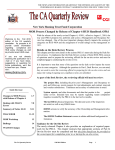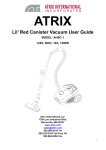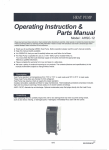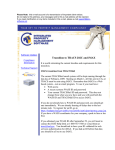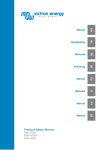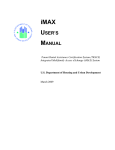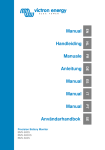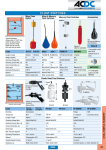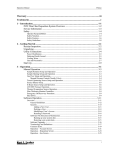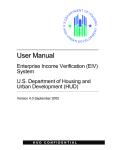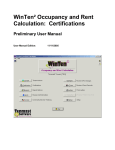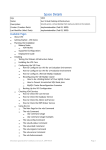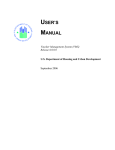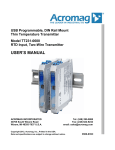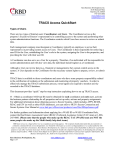Download The Quarterly Review
Transcript
The Quarterly Review Assisted Housing Services Corporation Fall 2010 In this Issue: Revised 4350.1 Chapter 6 2-7 Industry Workshop 7 TRACS Error Messages 8-9 TRACS/iMAX Rules of Behavior 10-11 REAC & Bed Bugs 11 Summary HUD Notice 10-10 12-14 HUD’s Smoke Free Housing Policy 15 Welcome to the Fall 2010 edition of the quarterly newsletter. The purpose of the newsletter is to provide useful information in regards to compliance and policy changes as well as provide recent HUD news. If you are not already receiving this publication via e-mail or if you have ideas, suggestions or questions for future publications, we’d like to hear from you. Please write to us at: [email protected]. The Quarterly Review Page 2 MOR Process Changed by Release of Chapter 6, HUD Handbook 4350.1 Did You Know? AHSC's FAQuestions are a collection of frequently asked questions. The questions have been divided into several categories. If you have a question or would like more information regarding a particular topic, please click on the appropriate link. If you have a question that is not listed, please fill out and submit the Contact AHSC form or call your CCS. With the release of the newly revised Chapter 6, 4350.1, effective August 1, 2010, the way your CA prepares for, performs and scores a Management and Occupancy Review has changed. One of the most important changes directly impacts the scoring of categories on HUD 9834 and the assignment of overall ratings on the management review. Details on the Desk Review Process This chapter provides more detail on the actions PBCA’s must take during the Desk Review process. It emphasizes that the Desk Review section of form HUD-9834 consists of questions used to prepare the reviewing official for the on-site review and must be completed prior to conducting the on-site review. It is important to note that some of the questions on the desk review impact the scores given in some categories. Although the questions in Part I, Desk Review, are not rated, they are used to assist the reviewing official in preparing for the on-site review and can impact the rating if ongoing noncompliance items are identified. As part of the Desk Review, the reviewing official will need to review: The project files—this usually includes the prior year’s Management and Occupancy report and follow-up, recent requests for rent adjustments and contract renewals and voucher submissions. Timeliness and accuracy of submissions is noted. System reports, and other documents and data that pertain to the project under review. Included here may be reports regarding tenant complaints/inquiries recorded by the PBCA in the last twelve months. The last REAC physical inspection iREMS screens to verify the accuracy of the Ownership and Management information. Guidance for the On-Site Review The newly released Chapter 6 also provides an explanation of required paperwork for the PBCA. The chapter instructs that appropriate sections of Part II, On-site Review must be completed and that the form should not be provided to the owner/agent for completion prior to or during the on-site review. When on-site, for subsidized projects, reviewers must complete: Addendum A -Tenant File Review Worksheet; Addendum B - Checklist for On-Site Limited Monitoring and Section 504 Reviews All reviewing officials should notate “N/A” for questions that are not relevant to the program under review. Addendum C - Documents To Be Made Available By Owner/Agent. Page 3 The Winter 2009 Quarterly Review The on-site review also requires follow-up and monitoring of inspections if deficiencies are noted on the physical inspection report released within the last twelve months and/or if information is available requiring corrective action. Included in the PBCA review are: A sampling of Exigent, Health, and Safety (EH&S) problems identified in the REAC physical inspection if the report was released within six months prior to the on-site review. A sampling of units and common areas to verify that significant REAC physical inspection report deficiencies (other than EH&S).… have been corrected The lead-based paint certification (if applicable) and noting deficiencies and/or environmental hazards if information is made available requiring corrective action. PBCA’s will obtain a copy of this document. Clarification of Communicating Results/Follow-Up Once on-site activities are completed, reviewers begin compiling data and write the report. Per Chapter 6, the following requirements impact this process: If report contains deficiencies, Target Completion Dates may not exceed 30 calendar days. The Government Accounting Office considers the monitoring process to be completed only after identified deficiencies have been corrected, the corrective action produces improvements, and it is determined that no further action is required. The Chapter has clarified the requirements for appealing Management and Occupancy scores by adding to the chapter the following detail: ―If an owner/agent receives a ―Below Average‖ or ―Unsatisfactory‖ overall rating as indicated on the form HUD-9834, Summary Report, the owner/agent may appeal the rating.‖ Per the language above, ―Below Average‖ and ―Unsatisfactory‖ category ratings cannot be appealed. Appeal process/timelines have not changed. Major Changes to the Scoring Process Note: All of the information that follows is new and substantively changes the process going forward. Significant changes to this section of the chapter include the addition of new performance indicators based on a numeric construct. As a result, each category is given a number based on the rating (Superior, Above Average, Satisfactory, Below Average and Unsatisfactory) as well as a weighted factor in the overall score. Helpful Links: Special Claims Processing Guide (06/06): http://www.hud.gov/ offices/adm/hudclips/ guidebooks/HSG-06-01/ index.cfm Special Claims Processing FAQs: http://www.hud.gov/ offices/hsg/mfh/rfp/ faq_scpg.pdf Special Claims forms: http://www.hud.gov/ offices/adm/hudclips/ forms/ The Quarterly Review Page 4 The performance indicators/values for categories on the 9834 are as follows: Superior (90-100) Above Average (80-89) Satisfactory (70-79) Below Average (60-69) Unsatisfactory (59 and Below) AHSC NEWS AND INFORMATION IS PUBLISHED QUARTERLY FOR OWNERS AND AGENTS OF THE ASSISTED HOUSING SERVICES CORPORATION Each category on HUD 9834 receives a number based on the frequency of findings and the degree of severity. For example, in Leasing and Occupancy, a reviewer may determine that the owner performance is Satisfactory. Based on the number of findings and the impact to overall compliance, a reviewer can then assign a rating between 70-79. This same process holds true for each category. HUD has added to this chapter clear, complete definitions of each of the ratings above. For full details, please see the complete Chapter 6 of 4350.1 posted at http://www.hud.gov/offices/adm/hudclips/handbooks/hsgh/4350.1/index.cfm. Below is a summary of each rating requirement. Superior Rating: Consistent policies and procedures which are highly successful in carrying out the objectives of HUD housing programs Owner/agent strictly adheres to procedures, resulting in compliance with the regulatory agreement, subsidy and mortgage contracts, and management certifications; The owner/agent is in compliance with HUD’s lead-based paint requirements (if applicable); The property is in exceptional condition and there are no observable Exigent, Health & Safety (EH&S) or other deficiencies; and, There are few incidences of errors disclosed in the review and no major adverse findings. There is ample documentation that the owner/agent periodically updates the affirmative fair housing marketing plan (AFHMP) marketing strategies, to address changing local demographics, including persons with limited English proficiency (LEP), person with a variety of disabilities, and large families. The owner/agent also engages in active outreach efforts to community groups and other organizations to attract individuals of available housing opportunities. The Quarterly Review Page 5 Above Average: The previous version of the chapter contained no guidance regarding what the minimum requirements were to receive this rating. With the issuance of this chapter, HUD has described this rating in detail. To receive an ―Above Average‖ rating an owner should: Have established policies and procedures which are successful in carrying out the objectives of HUD housing programs Adhere to procedures, with very few exceptions, resulting in compliance with the Regulatory Agreement, subsidy and mortgage contracts, and management certifications Be in compliance with HUD’s lead-based paint requirements (if applicable); Maintain the property is in good condition and there are no observable Exigent, Health & Safety (EH&S) or major deficiencies, but a minimal number of minor deficiencies are observable; and, Incidences of errors disclosed in the review are minimal and there are no major adverse findings. The HUD approved AFHMP is available on site, project staff have been trained on implementing the plan and it serves as the primary basis for marketing outreach to the various demographics groups that are lest likely to apply. Records are maintained on the demographics of applicants and tenants along with data that analyzes the effectiveness of the affirmative marketing efforts. Satisfactory: Per Chapter 6, a category should be rated Satisfactory IF: Owner/agent is successfully carrying out the objectives of HUD programs; Policies and procedures have been established but are not always adequate to prevent errors from occurring; The owner/agent submitted a lead hazard control plan within the prescribed HUD timeframe and is awaiting HUD approval (if applicable); There are some observable Exigent, Health & Safety (EH&S)/major deficiencies but there is evidence that the owner has already corrected many of the deficiencies noted on the last inspection report; The owner/agent or their employees have deviated from established policies resulting in deficiencies or there are findings that, with minor adjustments to existing policies or procedures or additional training, the owner/agent should be able to cure the deficiencies. In such cases, a satisfactory rating should be given only if the owner/agent is willing to make the necessary adjustments and complete the necessary training. The HUD approved AFHMP is available in the rental office and affirmative marketing to those least likely to apply occurs based on the Plan, including outreach in other languages to individuals who are limited English proficient (LEP). Change in HUD forms 9887 and 9887A As of 7/1/2010, Charles Hillman is the new President/Chief Executive Officer for Columbus Metropolitan Housing Authority. AHSC has notified their O/As to update their 9887 / 9887-As via the voucher reconciliation report. O/A’s should be sure the forms currently in use have the correct information included to avoid potential findings during an MOR The Quarterly Review Page 6 Below Average: Performance should be rated Below Average if actions rarely meet statutory, regulatory, and Handbook requirements and: Owners/agents policies and procedures are ineffective or inappropriate for the project; The policies and procedures do not meet the requirements of the regulatory agreement, management certification, or subsidy contracts; Weaknesses in policies and procedures result in frequent failures to comply with published HUD instructions; There are repeat major adverse findings; There are open findings from prior year’s management reviews; The owner/agent submitted a lead hazard control plan and has failed to comply with the HUD approved plan (if applicable); There are a substantial number of observable Exigent, Health & Safety (EH&S)/major deficiencies and there is evidence that the owner has corrected very few of the deficiencies noted on the last inspection report; and, Policies and procedures or the owner/agent or on-site employees would need significant amounts of training to cure the deficiencies. The HUD approved AFHMP is available in the rental office but the AFHMP is not utilized as required. Unsatisfactory The following conditions are indicators of an ―Unsatisfactory‖ rating in any one category: Owners/agents actions or failure to act have placed the Secretary’s interest in jeopardy or frustrated achievement of the Secretary’s housing objectives; There are major adverse findings in the financial management/procurement processes (HUD would determine this) There are repeat major adverse findings; There are open findings from prior year’s management reviews; The owner/agent has failed to submit a lead hazard control plan to HUD (if applicable); There are many observable Exigent, Health & Safety (EH&S)/major deficiencies The owner/agents actions have failed to meet state and local housing code requirements (regardless of REAC score); and, The owners/agents policies and procedures are ineffective or lacking to the extent that the owner/ agent frequently, and often seriously, fails to comply with HUD’s regulations and published instructions. There is no HUD approved AFHMP available in the rental office. Overall Rating Calculation These HUD defined Performance indicators (or ratings) are assigned to each category and are used to determine and monitor owner/agent compliance with HUD requirements. Once the reviewer has assigned these performance indicators, each category, in turn, is weighted based on its overall impact at the property. The Quarterly Review The chart below identifies the weight HUD has given to each category rating on the Management Review: Weights of Each Category A. General Appearance and Security B. Follow-up and Monitoring of Project Inspections C. Maintenance and Standard Operating Procedures D. Financial Management/Procurement E. Leasing and Occupancy F. Tenant/Management Relations G. General Management Practices 10% 10% 10% 25% 25% 10% 10% 100% NOTE: “Financial Management/Procurement” is not rated by PBCA’s and as such is taken out of the final, overall calculation. Each of these contributes to the overall score on the Management and Occupancy Review as follows: In determining the overall rating, the reviewing official must first multiply the performance indicator value by the assigned percentage of the overall rating for each category, rounding up to the nearest whole number. Once all categories have been calculated based on the performance indicator and performance indicator values, the total is divided by the total percentage points. Note: This is done mathematically, so reviewer has no discretion in changing the final number. The information provided in this article summarizes the complete changes and detailed discussions included in the actual Chapter 6 of 4350.1. Owners and Agents should read the entire chapter carefully to gain a complete understanding of all of the changes included in this newly released guidance. AHSC Industry Workshop AHSC has again reached out to assist and inform the industry on the critical events and topics that are affecting our industry. On September 29th and 30th, AHSC held an industry workshops for members of the Multi-family Housing Industry. We appreciate the attendance of over 200 members of various housing groups that attended. The topics that were discussed during this workshop included Exigent Health and Safety (EH&S) - What is AHSC’s role with EH&S issues Vouchers - Tips and Hints on successful vouchering as well as understanding your reconciliation report Policy Updates - EIV, MOR Scoring (4350.1 Chapter 6) and Contract Renewal Process O/A Portal Presentation - gaining access and the useful tools that exist within the portal Roundtable Discussion - Questions and Answers on issues that are affecting Owners & Agents Over the upcoming year AHSC anticipates conducting additional workshops on topics that are critical to the industry. Please continue to check www.cgihousing/events.com for future events. The Quarterly Review Page 8 Understanding TRACS Error Messages To understand TRACS error messages, first Owner/Agents must understand how the TRACS system works toward paying their monthly vouchers. Owner/Agents send their MAT 30 and updated certifications to their PBCA. Once AHSC forwards a voucher/certification to TRACS, TRACS messages are then sent back to our TRACS mailbox which in turn are forwarded to Owner/Agents’ TRACS mailboxes. Owner/Agents must download these messages from their software system (contact your software vendor for instructions). We recommend downloading error messages at least weekly to ensure all issues are resolved. Once Owner/Agents have received the messages, they must address them. Not all TRACS messages carry the same weight or importance. These messages are divided into 3 types: Informational/Confirmation of files received Discrepancy Error Messages Fatal Error Messages TYPE 1: Informational/Confirmation of Files Received: These messages are sent from TRACS confirming the receipt of a file. They contain a brief explanation as to what file was received. Usually the CA or O/A will not have to follow up on these messages. However, it’s imperative these messages are read completely to make that determination. TRACS does not send informational or ―confirmations‖ messages for full certifications (Annual Recertifications, Interim Recertifications, Initial Certifications or Move In). Sample messages: Voucher: VSP10: Voucher has been accepted for payment. Voucher ID 1234567890. Certification: GA002: MAT70 Gross Rent Change Successfully processed. TYPE 2: Discrepancy Error Messages: These error messages are sent from TRACS confirming the certification has been received. However, these certifications may require additional items to be corrected or at the very least reviewed for accuracy. These messages have Action Required codes listed in a column that indicates the correction submission procedures and designate those messages that are informational. ACTION CODES: 01 - Submit correction within 45 days. 02 - Submit correction on next submission and/or certification. 03 - Informational message; may or may not require correction. 04 - Follow up required (For Field Office Use Only). Once Owner/Agents receive a Discrepancy error message they should review the Action required code to determine a course of action. Research these errors using the MAT User Guide located at http:// www.hud.gov/offices/hsg/mfh/trx/trxmatg.cfm Appendix D. This section of the MAT User Guide also provides a Recommended Solution area with suggestions on how to resolve these discrepancies. The Quarterly Review TYPE 3: Fatal Error Messages: These error messages indicate that a certification has failed the TRACS edit check procedures. AHSC software is designed to fail these certifications during the vouchering process. However, there are cases where we may accept a certification that will still fail TRACS. Certifications that fail TRACS will have an “F” in front of the number code; for example F0012.These failed certifications need to be addressed immediately as they can have an impact on TRACS compliance and EIV reports. Review the TRACS error code to determine your course of action. These errors need to be researched using the MAT User Guide located at http://www.hud.gov/offices/hsg/mfh/trx/trxmatg.cfm Appendix E. This section of the MAT User Guide also provides a Recommended Solution area with suggestions on how to resolve these errors. Any certifications that may need to be corrected will have to be transmitted through iMAX to AHSC and we will then forward the certification to TRACS (as long as it passes our edit checks). TRACS will then check that certification for validity and will either post the certification or fail it and the process will repeat itself. Any questions related to your TRACS error messages can be sent to your Central Contract Specialist. The Quarterly Review Page 10 TRACS/ iMAX Rules of Behavior The Deadline for accepting the TRACS Rules of Behavior and completion of the Security Training has been extended to October 1, 2010. TRACS users must accept the TRACS Rules of Behavior through the Integrated Multi-family Access Exchange System (iMAX) or TRACS Menu Link via HUD’s Secure Systems (WASS). Any TRACS user that submits tenant and voucher data to HUD via vendor software and/or iMAX web services will not be able to transmit data after October 1, 2010 if they have not previously accepted the ROB and completed the required Security Training. If you have any questions regarding the Rules of behavior Requirements please email [email protected]. To accept the Rules of Behavior: 1. Access HUD’s Secure Systems http://www.hud.gov/offices/reac/online/reasyst.cfm 1. Log in using your own user name (MID) and password 2. Click on the integrated Multi-family Access Exchange System (iMAX) link or the TRACS link (both of these systems share the same ROB so it only has to be accepted once per year) The Rules of Behavior (ROB) page will appear automatically. If for some reason the ROB does not appear, manually print the ROB using the following web link: http:// www.hud.gov/offices/hsg/mfh/rhiip/eiv/tracseivaccessinternal.pdf To complete online TRACS Security Awareness training: 1. Go to http://iase.disa.mil/eta/index.html#onlinetraining See graphic below: 2. Click on the Federal ISS Awareness icon. The Quarterly Review 3. Once you start the course, you should complete it in its entirety, as the system does not authenticate users and will not save your progress. 4. Upon completion of the course, print the certificate confirming you completed the course. Sign and file the certificate. (HUD may ask for this document) WASS ID Changes Recently, changes were put into effect that tightened security at HUD, especially surrounding Secure Systems and TRACS Query. If your WASS id begins with the letter "I", you can no longer access TRACS Queries, and should follow these steps to disable your current "I" id and obtain a new "M" WASS id: 1) Have your System Coordinator remove all "roles" from your "I" id and it will automatically go "Inactive" 2) New "M" id: https://hudapps.hud.gov/public/wass/public/participant/partreg_page.jsp 3) The process should take approximately 24 hours, but if questions, email [email protected] Additionally, if you have recently received a new WASS id and were surprised it began with the letter "I", but were expecting a "M", please follow the same procedures above to ensure uninterrupted system access. REAC Announces New Bed Bug Infestation Protocol Effective September 13, 2010 all inspectors are required to report the presence or existence of bed bugs at any property being inspected. Further, if the management agent states that a unit is infested with bed bugs, the inspector will not enter that unit. The presence and/or treatment of bed bugs will not be scored in the UPCS inspection. This data, however, is being collected to ensure that HUD program participants maintain HUD properties in decent, safe and sanitary condition, and in good repair. To read the protocol in its entirety, please visit: http://www.hud.gov/offices/reac/products/pass/PDFs/ bedbugs-notice.pdf The Quarterly Review Page 12 Summary of HUD Notice 10-10 and Changes from 09-20 Several important updates to EIV requirements were released with this notice. Owner/Agents should carefully read the entire notice to ensure compliance with its provisions. A complete copy of the notice can be found at: http://portal.hud.gov/portal/page/portal/HUD/programoffices/administration/hudclips/ notices/hsg What follows below is a summary of the main points included in the notice. Some of the key points and changes: Information for one household member cannot be shared with another household member without written consent. EIV users must participate in annual EIV training as well as annual EIV security training. HUD’s most recent webcast can be used to comply with this requirement. Owners and Agents will need to keep a list of those that attended as well as the date the training was held. For a more complete list of what will suffice as Security Training reference section XII F. of HUD notice 10-10 HUD has updated information regarding tenant notification of possible identity theft. HUD has provided much clearer instruction about the required timing for running EIV reports Document retention issues have been clarified. HUD has provided much clearer instruction about the required timing for running EIV reports Existing Tenant Report – must be run prior to Move – In (at time of tenant selection) Must be held with Application in tenant file for tenancy plus 3 years. Must also be held in rejection file with supporting documents for 3 years Failed Pre-Screening/Failed Verification – both reports must be run monthly The O/A is required to document efforts to resolve any discrepancies identified in these reports. Deceased Tenant – Must be run at least quarterly and as indicated in the property’s EIV policies The O/A is required to document efforts to resolve any discrepancies identified in this report. New Hires Report – at least quarterly and as indicated in the property’s EIV policies Multiple Occupancy Report – at least quarterly and as indicated in the property’s EIV policies The O/A is required to document efforts to resolve any discrepancies identified in this report. Income Report – New requirement that O/A’s must run this report within 90 days after the Move-In 50059 is entered into TRACS Income Report/Income Discrepancy Report - at annual and interim and as indicated in the property’s EIV policies The O/A is required to document efforts to resolve any discrepancies identified in these reports No Income Report – As indicated in the property’s EIV policies O/As should refer to the EIV User Manual for Multifamily Housing Program Users for assistance on ac- The Quarterly Review cessing the reports and for further descriptions of the reports. The manual is posted at: http:// www.hud.gov/offices/hsg/mfh//rhiip/eiv/eivhome.cfm. Repayment Agreements All new repayment agreements as of Notice 10-10 (effective July 1, 2010), must include specific language as indicated in the notice. For full details of the requirements O/A’s should refer to the notice. Items that must be included are below: Must contain a clause that says the repayment amount will be renegotiated if the household in- come increases or decreases by $200 or more per month Reference the paragraphs in the lease whereby the tenant is in non-compliance and may be subject to termination of their lease Include the total retro/active rent amount owed, the amount of lump sum paid, if applicable, and monthly payment amount Include a statement that the monthly retro/active rent payment is in addition to the family’s rent payment Late and missed payments constitute default of the agreement and may result in termination of assistance and/or tenancy Be signed and dated by both tenant and the O/A Other Important Guidance Resident files may contain information for members of that resident’s household only Owners should be sure to cut or block out any information that pertains to other tenants since the reports do not run for individual tenants. Owner/agents must note, on Failed Pre-Screening reports when residents are exempt from SSN disclosure requirements per Notice 10-08 and 10-10 Owner/agents taking over new properties have 90 days to obtain access to EIV. To minimize the risk of exposing a tenant’s SSN, O/As may remove and destroy, at the time of recertification, copies of verification documentation received from the tenant at the time of disclosure of their SSN once the Identity Verification Status shows ―Verified‖. O/As are encouraged to minimize the number of tenant records that contain documents that display the full nine-digit SSN. O/As must not include the full nine-digit SSN for a tenant in emails or other electronic communications. Master Files Required Owner/agents must retain a ―Master‖ file that contains the summary report of the reports noted below as well as in the detailed report in the tenant file when discrepancies are identified. The O/A is also required to place documentation or notations in the files as indicated in the notice. The Master files must be available at the MOR to provide verification of compliance with Notice 10-10. The Quarterly Review Page 14 Master files are required for the following reports: New Hires Multiple Subsidy Report Verification Reports which would include – Failed Pre-screening report and the Failed Verification Report (SSA identity match). Deceased Tenant Report Once the retention period has expired, O/As must dispose of the data in a manner that will prevent any unauthorized access to personal information, e.g., burn, pulverize, shred, etc. Disclosure to Persons Assisting Tenants with the Recertification Process With the written consent of the tenant, EIV data may be shared with persons assisting the tenant with the recertification process. Tenants who require assistance during the recertification process may have a representative present to assist them in their ability to participate in the recertification process; this includes review and explanation of the written third party income verifications. Disclosure of EIV information to these parties must be employment or income information pertaining only to the tenant who has provided his/her consent. These parties must not have access to EIV information for any other household members. Residents can provide written consent for the following to view EIV information to assist them in their ability to participate in the recertification process only: Service coordinators have access to the data only if they are present at and assisting the resident with the recertification process Translators/interpreters Individuals assisting an elderly individual or a person with a disability Guardians Powers of attorney Other family members For a more complete list of who may be authorized to view the income reports reference section XII C. of HUD notice 10-10 To ensure full understanding of the notice and your responsibilities regarding EIV, please go to: http://portal.hud.gov/portal/page/portal/HUD/program_offices/administration/hudclips/notices/hsg The Quarterly Review Page 15 HUD Issues New Optional Smoke Free Housing Policy On September 15, 2010, HUD issued Notice H10-21 which detailed the Optional Smoke Free Housing Policy Implementation. The purpose of the notice is to encourage O/As to implement smoke-free housing policies in some or all areas of their respective properties. At this time, HUD is not mandating that O/As make their properties smoke-free, however this notice highly encourages owners to consider it, as there are many health benefits to a smoke-free environment. O/As choosing to establish smoke-free housing policies may establish policies that allow smoking in individual units but prohibits smoking in all common areas or policies to create a totally smoke-free property. If Owner/Agents choose to establish such policies, they must: · Be in accordance with all state and local laws. · Address smoking in tenant’s unit, common areas, playground areas, areas near any exterior window or door, and areas outside a tenant’s unit. · Designate specific smoking areas and identify these areas with clear signage unless the O/A establishes a totally smoke-free policy. If Owner/Agents choose to establish such policies, they must not: · Deny Occupancy to any individual who smokes . · Ask the applicant or tenant if any member of their household smokes. · Maintain smoking and nonsmoking specific waiting lists for the property. · Require existing tenants, as of 9/15/2010, to move– out of the property or transfer to another unit. O/As have the option to grandfather current tenants. O/As also have the option to establish smoke-free wings, buildings, floors and/or units at their property; however these policies must be clearly defined in their House Rules. O/As who have already established smoke free policies may continue to enforce their current policies as long as they do not violate the guidance provided in HUD notice 10-21. If an Owner/Agent wishes to implement smoke-free policies, they must update their House Rules and notify existing tenants who have completed their initial lease term 30 days prior to implementation of such policies. For tenants who have not yet completed their initial lease term, the owner must provide the change in the House Rules to the tenant with a 60 day notice, prior to the end of their lease term. Penalties for violating the House Rules may be considered material noncompliance with the lease and may result in termination of tenancy. To read the notice in its entirety, please visit: http://portal.hud.gov/ portal/page/portal/HUD/program_offices/administration/hudclips/notices/hsg/files/10-21hsgn.pdf















